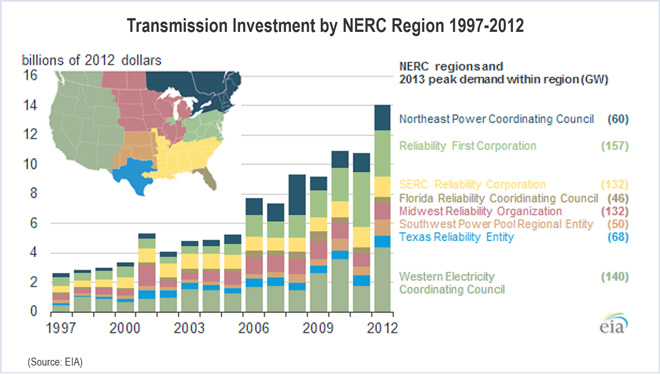The Federal Energy Regulatory Commission on Thursday issued new reliability standards, denied rehearing on business practices and communication protocols and ordered a new format for electronic filing of required reports. The commission also outlined a plan for measuring the effectiveness of its initiatives to spur transmission spending.
Transmission Investment Metrics

The metrics are intended to measure levels of transmission infrastructure by region and permit analysis of the impact of commission transmission policies.
They include two measures of persistent congestion, which FERC said would provide an indication of whether regions have invested enough in transmission to ensure reliability and reduce costs:
- Annual number of Transmission Loading Relief (TLR) or unscheduled flow events, normalized based on retail load. This metric would apply in bilateral markets.
- Persistence, in years, of price differentials between RTO/ISO market nodes and market-to-market flowgates. LMPs, forward capacity prices and trading hub prices will be used.
To gauge the impact of policy changes, three other metrics will measure relative transmission investment and the cost-effectiveness of that spending:
- Circuit-miles of transmission added to the grid, normalized by retail load. Population density and other factors may need to be considered in using the metric to compare regions.
- Load-weighted transmission investment, defined as the amount spent on new capital additions in a given year, weighted by retail load. Population density must be considered in comparisons.
- Circuit-miles per dollar of investment, defined as the number of circuit-miles added in a year, divided by the total invested — a measure of cost effectiveness.
The final metric will attempt to measure the impact of Order 1000, which sought to open transmission development to competition. It would divide the number of bids or proposals from non-incumbents in a region by the total number of bids and proposals annually.
“This is important work that you’re doing,” Chairman Norman Bay told Ben Foster, an Office of Energy Policy and Innovation staff member who presented the metrics study to the commission. “The metrics presented by staff today will allow the commission and its staff to better see what works and what needs further improvement.”
FERC staff will consider whether to add more metrics as it gains experience with the initial six.
“This is an initial feasibility study,” Foster said in response to a question from Commissioner Philip Moeller on a timeline for further developments. “We’ve done an initial pass, but we want to look more deeply into it to see if in fact it will yield meaningful insights. So we don’t have a particular timeline for releasing any kind of analysis at this point.”
FERC spokeswoman Mary O’Driscoll said the effort will not impose any additional reporting requirements on RTOs or others, at least not immediately.
“This is the very beginning of the process,” she said. “If [FERC staff] need additional data they will seek it out at the time. For now, it’s all public data.”
Commissioner Cheryl LaFleur asked Foster if there was anything RTOs could do to help FERC get meaningful data.
Foster replied that staff is attempting to rely on publicly available data. “But we may well have questions, and if the people who compile that data would be open to helping to walk us through [it] … that would be the most helpful to us at this point,” he said.
Electronic Filing Protocols for Commission Forms
Electric utilities and others will be required to file FERC reports in XML (Extensible MarkUp Language), a replacement for the current software, Visual FoxPro, which is no longer supported by its developer, Microsoft.
Affected are four forms used by electric utilities:
- Form 1: Annual Report of Major Electric Utilities, Licensees, and Others;
- Form 1F: Annual Report of Nonmajor Public Utilities and Licensees;
- Form 3Q: Quarterly Financial Report of Electric Utilities, Licensees, and Natural Gas Companies; and
- Form 714: Annual Electric Balancing Authority Area and Planning Area Report.
Forms for natural gas companies and oil pipelines also are affected by the change (AD15-11).
Standards for Business Practices and Communication Protocols for Public Utilities
FERC denied a request by the Edison Electric Institute for rehearing of Order 676-H, which specified business practices and communication protocols for electric utilities. The order addressed redirect policies and included a requirement that transmission providers post on their Open Access Same-time Information Site (OASIS) explanations on their calculation of available transmission capacity (ATC) within one day (RM05-5-024). Compliance is required effective May 15.
Reliability Standards
The commission gave final approval to the following reliability standards developed by the North American Electric Reliability Corp.:
- COM-001-2 (Communications) and COM-002-4 (Operating Personnel Communications Protocols). The rules require adoption of predefined communication protocols, including use of three-part communications, and an annual assessment of them. The commission ordered NERC to modify COM-001-2 to address internal communications that could have an impact on reliability (RM14-13).
- BAL-001-2 (Real Power Balancing Control Performance) and four new definitions. The standard is intended to ensure that the grid maintains consistent system frequency. It adds a frequency component to the measurement of a Balancing Authority’s area control error (ACE). The commission ordered NERC to submit an informational filing on the potential impact of the standard and to revise one definition (RM14-10).
The commission also gave preliminary approval to, and invited comment on, two Notices of Proposed Rulemaking:
- PRC-005-4 (Protection System, Automatic Reclosing and Sudden Pressure Relaying Maintenance), which requires testing and maintenance of certain sudden pressure relays. The commission said it plans a new definition and four revised definitions in the proposed standard (RM15-9).
- PRC-002-2 (Disturbance Monitoring and Reporting Requirements), designed to ensure the availability of adequate data to allow analysis of bulk electric system disturbances (RM15-4).
Tech Conference on Reliability of Bulk Power System
FERC will hold its annual technical conference on the reliability of the bulk-power system on June 4 (AD15-7). The conference, which will be held at FERC headquarters, will be webcast. FERC said a detailed agenda will be issued later.
— Rich Heidorn Jr.



